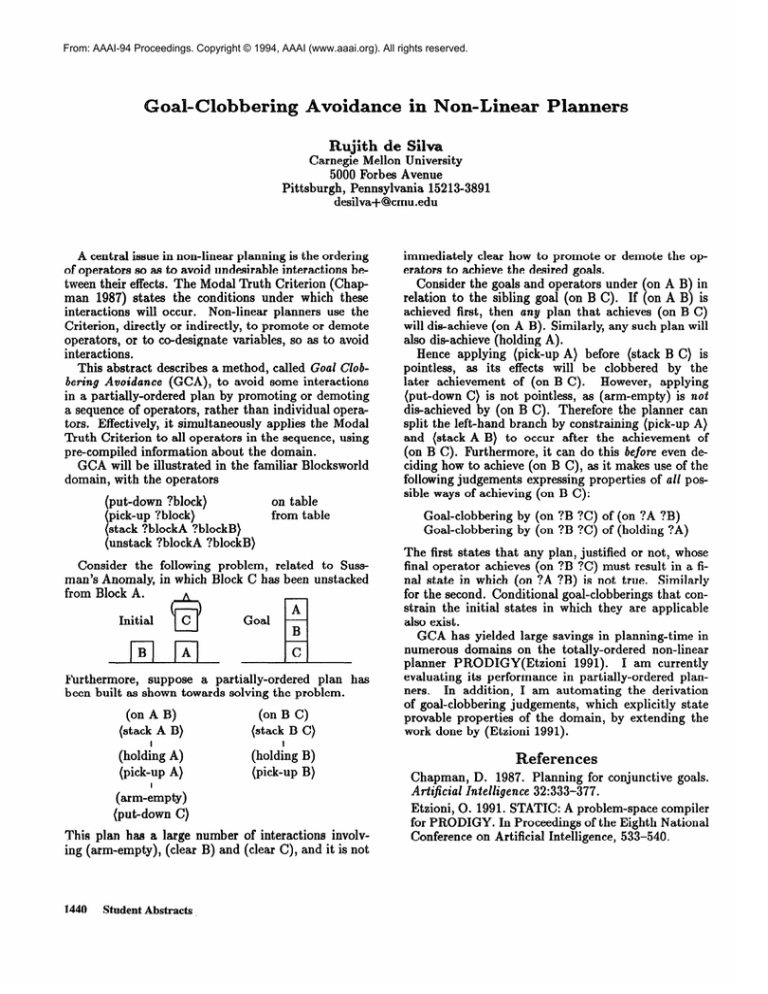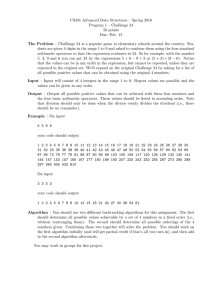
From: AAAI-94 Proceedings. Copyright © 1994, AAAI (www.aaai.org). All rights reserved.
Goal-Clobbering
Avoidance
Rujith
in Non-Linear
Planners
de Silva
Carnegie Mellon University
5000 Forbes Avenue
Pittsburgh, Pennsylvania 15213-3891
desilva+@cmu.edu
A central issue in non-linear planning is the ordering
of operators so as to avoid undesirable interactions between their effects. The Modal Truth Criterion (Chapman 1987) states the conditions under which these
interactions will occur. Non-linear planners use the
Criterion, directly or indirectly, to promote or demote
variables, so as to avoid
operators, or to co-designate
interactions.
This abstract describes a method, called Goal Clobbering Avoidance (GCA), to avoid some interactions
in a partially-ordered plan by promoting or demoting
a sequence of operators, rather than individual operators. Effectively, it simultaneously applies the Modal
Truth Criterion to all operators in the sequence, using
pm-compiled information about the domain.
GCA will be illustrated in the familiar Blocksworld
domain, with the operators
(put-down ?block)
(pick-up ?block)
(stack ?blockA ?blockB)
(unstack ?blockA ?blockB)
on table
from table
Consider the following problem, related to Sussman’s Anomaly, in which-Block C has been unstacked
from Block A.
A
Goal
RB
Furthermore, suppose a partially-ordered plan has
been built as shown towards solving the problem.
(on A B)
(stack A B)
(on B C)
(stack B C)
(holding A)
(pick-up A)
(holding B)
(pick-up B)
(arm-empty)
(put-down C)
This plan has a large number of interactions involving (arm-empty), ( c1ear B) and (clear C), and it is not
1440
Student Abstracts
immediately clear how to promote or demote the operators to achieve the desired goals.
Consider the goals and operators under (on A B) in
relation to the sibling goal (on B C). If (on A B) is
achieved first, then any plan that achieves (on B C)
will d&achieve (on A B). Similarly, any such plan will
also dis-achieve (holding A).
Hence applying (pick-up A) before (stack B C) is
pointless, as its effects will be clobbered by the
later achievement of (on B C).
However, applying
(put-down C) is not pointless, as (arm-empty) is not
dis-achieved by (on B C). Therefore the planner can
split the left-hand branch by constraining (pick-up A)
and (stack A B) to occur after the achievement of
(on B C). Furthermore, it can do this before even deciding how to achieve (on B C), as it makes use of the
following judgements expressing properties of csll possible ways of achieving (on B C) :
Goal-clobbering
Goal-clobbering
by (on ?B ?C) of (on ?A ?B)
by (on ?B ?C) of (holding ?A)
The first states that any plan, justified or not, whose
final operator achieves (on ?B ?C) must result in a final state in which (on ?A ?B) is not true. Similarly
for the second. Conditional goal-clobberings that constrain the initial states in which they are applicable
also exist.
GCA has yielded large savings in planning-time in
numerous domains on the totally-ordered non-linear
planner PRQDIGY(Etzioni
1991). I am currently
evaluating its performance in partially-ordered planners. In addition, I am automating the derivation
of goal-clobbering judgements, which explicitly state
provable properties of the domain, by extending the
work done by (Etzioni 1991).
References
Chapman, D. 1987. Planning for conjunctive goals.
Artificial Intelligence 32~333-377.
Etzioni, 0. 1991. STATIC: A problem-space compiler
for PRODIGY. In Proceedings of the Eighth National
Conference on Artificial Intelligence, 533-540.



